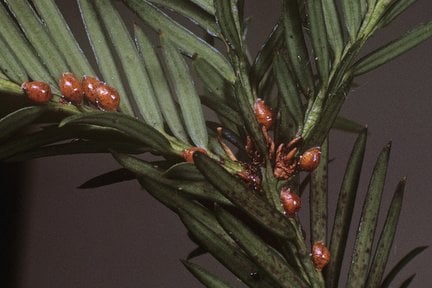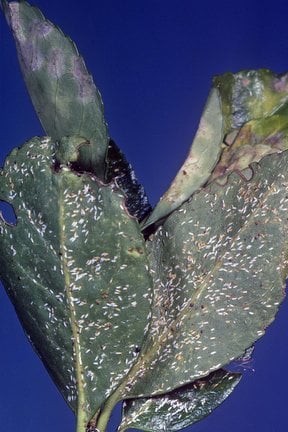
Quick facts
Common name - Yew scale
Scientific name - Parthenolecanium pomeranicum
Plants affected - Yew (Taxus)
Main symptoms - Brown, oval convex shell-like objects on the leaves and branches
Most active - All year
What is yew scale?
Scale insects are sucking true bugs belonging to several families in the Hemiptera. Typically the adults are immobile having a flattened or raised appearance, with no visible legs. They often look like a ‘scale’ on a leaf or stem, many species produce a white wax often covering egg masses. There are more than 100 species found in Britain, 26 of which have been introduced. More than 25 species can be found in gardens or on houseplants.
Yew scale is a sap-sucking insect that lives mainly on the leaves and stems of yew (Taxus). It is similar in appearance to brown scale however, brown scale is found on a wide range of plants but notTaxus. Yew scale has one generation a year and in early summer the adult insects can be seen on the leaves and stems. The eggs hatch in late June and July and the young scale nymphs then disperse and feed during the summer by sucking sap from the leaves. It is not unusual to find light populations of this scale on healthy yew plants.
Symptoms
- Convex, oval, dark brown ‘shells’, 3-6 mm long, occur on the woody stems
- It is not unusual to find this scale on yew, only heavy populations may affect vigour and cause defoliation
- A black sooty mould often develops on the sugary honeydew, that is excreted by the insects as they feed on and deposited on leaves and stems
Management
- Light populations of yew scale are of little consequence on yew trees, indeed they are normal for a healthy yew and can usually be tolerated; well-tended, smaller, healthy plants are able to tolerate light populations of these insects
- Encourage predators in the garden; yew scale is a food source for some ladybirds , and other predators. Natural enemies will often keep populations of this insect in check













